

Administration: Upgrade
This chapter describes the upgrade functions for the IBM System Storage DCS3700 storage subsystem. It covers the steps to upgrade the storage subsystem firmware and NVSRAM microcode. These functions are accessible through the DS Storage Manager (Enterprise Management) or DS Storage Manager (Subsystem Management).
14.1 The Subsystem Management Upgrade menu
This section lists the upgrade functions that are accessed from the DS Storage Manager (Subsystem Management) Monitor menu, as shown in Figure 14-1.

Figure 14-1 The DS Storage Manager (Subsystem Management) Upgrade menu
The Upgrade menu (Figure 14-1) consists of the following items:
•View firmware Inventory: Collects and displays all firmware information from the system, as described in 14.2.2, “Firmware inventory” on page 425.
•Controller Firmware: Used to start the firmware updates, activation, and cleaning, as described in 14.3, “Upgrading the DCS3700 controller firmware” on page 428.
•Controller NVSRAM: Used for NVSRAM update operations only, as described in 14.4, “Controller NVSRAM” on page 453.
•Drive Firmware: Updates the hard disk drive firmware version, as described in 14.5, “Drive firmware” on page 455.
•ESM Firmware: Updates the External Enclosure card firmware version, as described in 14.6, “ESM firmware” on page 460.
•Enclosure Configuration Settings: Allows the transferal of configuration settings to and from External Enclosures, as described in 14.7, “Enclosure configuration settings” on page 462.
14.2 Downloading firmware
This section describes the steps that are completed to obtain the DCS3700 storage subsystem firmware and NVSRAM microcode. You can download the latest firmware from the following website:
Appendix A, “IBM Support Portal website” on page 583 describes this website and
its contents.
its contents.
On the same website, you can select (as shown in Figure 14-2, for the DCS3700) the firmware (controller firmware, NVSRAM, ESM, and disk firmware), HBA device drivers and firmware, RDAC multipath drivers, and the DS Storage Manager application. Also, the links for the product documentation, troubleshooting tips, and all other information regarding DCS3700 storage subsystemare available at this site.

Figure 14-2 Code downloads for DCS3700 storage subsystem
The DCS3700 firmware version is closely connected to the Storage Manager version, and the HBA device driver and firmware are available for your hosts. You should always check the DCS3700 firmware readme and change-history files to see whether there are any host software dependencies. If there is a newer version of Storage Manager (including multipath device drivers) or HBA software is required for the hosts, download and install these items first before updating the DCS3700firmware. The ESM firmware should also be upgraded to the required level (for more information, see 14.6, “ESM firmware” on page 460) before you start the controller firmware upgrade. In general, run at the latest levels unless
advised otherwise.
advised otherwise.
|
Note: Updating firmware normally requires a maintenance window, so it is better to plan an appropriate outage time in advance.
|
Download all the packages that you need from the IBM Support website and extract and store them on a local disk.
|
Important: The procedures in this section are provided as a guide. However, these procedures can change. Always carefully check the readme files that are distributed with any firmware package and follow those procedures exactly.
|
14.2.1 Before you upgrade
There are precautions that must be taken before you update a storage subsystem:
•Make sure that the overall system status is Optimal by checking the Summary tab of the Storage Manager Subsystem Management Window, as shown in Figure 14-3 on page 425. If not, run the Recovery Guru, as described in 13.2, “View Health (Recovery Guru)” on page 387, to diagnose and fix the problem before proceeding with the upgrade.
•Always read the appropriate readme file before upgrading any firmware to check for compatibility with your system.
•Take care with dual controller configurations. The upgrade procedure requires a management connection to both DCS3700controllers, and it is not possible to perform a firmware upgrade with only one controller connected. Therefore, both controllers must be online and accessible, either through an in-band or out-of-band management connection. If you upgrade redundant configurations in-band, make sure that a multipath driver is installed on the management host. This is necessary because the access logical drive moves from one controller to the other during this procedure and the DCS3700 controller must be manageable the entire time.
|
Note: The overall DCS3700Monitor status and current firmware version can be checked in the Summary tab of the Subsystem Management Window, as shown in Figure 14-3.
|

Figure 14-3 Viewing the DCS3700storage subsystem status in DS Storage Manager
|
General rule: Save the All Support Data collection described in 13.4, “Collect Support Data” on page 393 before starting any storage subsystem upgrades.
Notes:
•Update the hosts, and ensure that the correct version of the multipath driver is installed.
•Update the ESMs first to the latest level (as described in 14.6, “ESM firmware” on page 460) followed by the controller firmware. Outdated ESM firmware could make your expansion units inaccessible after the DCS3700storage subsystem firmware update. The required ESM firmware level for each controller firmware level is mentioned in the readme file for the controller firmware.
•Update the Controller firmware, followed by the NVSRAM. These two components must be updated together or immediately in this order.
•Any power or IP network, SAN, or SAS interruption during the update process might lead to configuration corruption. Therefore, do not power off the DCS3700storage subsystem or the management station during the update.
|
14.2.2 Firmware inventory
Before and after updating the firmware levels of the DCS3700storage subsystem, you can use the Firmware Inventory option to view the complete firmware levels for your
storage subsystems.
storage subsystems.
To view the firmware inventory for one storage subsystem, complete the following steps:
1. Click View Firmware Inventory in the Monitor pane of the Summary tab of the Storage Subsystem window (Figure 14-4).

Figure 14-4 Storage Subsystem - Monitor
2. Figure 14-5 shows the Firmware Inventory window that opens. Save the firmware inventory to a text file by clicking Save As.

Figure 14-5 Storage Subsystem - Firmware Inventory
To view the firmware inventory for more than one storage subsystem, complete the
following steps:
following steps:
1. Click Tools → Firmware Inventory from the Enterprise Management window. Figure 14-6 shows the Firmware Inventory window that opens. From this window, it is possible to select different storage subsystems.

Figure 14-6 Enterprise Management - Firmware Inventory
2. Save the firmware inventory to a text file by clicking Save As.
|
Note: If you want to save the firmware inventory for more than one storage subsystem, you must select each of the storage subsystems in the drop-down box and then click Save As.
|
14.2.3 Updating the host
Before you update the firmware on your DCS3700 storage subsystem, the software on your hosts should also be up to date. Go to the IBM Support website listed at the following URL to check the levels of Storage Manager and HBA drivers:
If newer versions are available, download them and check the readme files for any special requirements before you update.
Update the HBA driver and Storage Manager if necessary. Updating Storage Manager is described in Chapter 4, “IBM System Storage DS Storage Manager installation” on page 131. Storage Manager for Windows also includes the associated multipath driver. The multipath RDAC driver is a separate package for Linux. Other host operating systems provide their own multipath drivers. The required multipath driver must be updated on all attached hosts when multiple HBAs are installed.
|
Note: Updating the host server software might require a system reboot. You might need to plan downtime.
|
Also, check the HBA firmware to make sure that it is at the latest supported level. You can also find this information at the IBM Support website.
14.3 Upgrading the DCS3700 controller firmware
This section describes how you can upgrade the firmware of the controllers in the storage subsystem by using the DS Storage Manager software.
|
Important: During the update of one controller, all Fibre Channel links for this controller are disconnected. When the upgrade of the first controller is finished, the second one starts immediately with the firmware upgrade and the second controller drops all FC links. Some FC topologies need some time to re-establish the link to the first controller. So, this task can result in a complete loss of access for a short period.
|
14.3.1 Staged upgrades and activation
The process of upgrading the firmware is a two-stage process:
1. The firmware file is transferred from the management host to the DCS3700
storage subsystem.
storage subsystem.
2. The DCS3700 storage subsystem is upgraded with the new firmware file. The process of upgrading after downloading the firmware file is known as activation. During activation, the existing firmware file in the memory of the controller is replaced with the new
firmware file.
firmware file.
After transferring the firmware file, you can choose to automatically activate the controllers in the storage subsystem to the new firmware immediately. Optionally, you can transfer the firmware file to the controller and activate the firmware later. This is known as a
staged upgrade.
staged upgrade.
14.3.2 Pre-upgrade checks
The storage management software checks for existing conditions in the storage subsystem that prevent a successful firmware upgrade before upgrading the firmware. If it detects one of these conditions, the firmware upgrade tool reports the status of the DCS3700storage subsystem as non-upgradeable (see Figure 14-8 on page 432). Any of the following conditions can prevent the firmware upgrade:
•An unsupported controller type or controllers of different types that are in the storage subsystem that cannot be upgraded.
•One or more failed drives.
•One or more hot spare drives that are in use.
•One or more arrays that are incomplete.
•Operations, such as defragmenting an array, downloading drive firmware, and others, that are in progress.
•Missing logical drives that are in the storage subsystem.
•Controllers that have a status other than Optimal.
•The storage partitioning database is corrupted.
•A data validation error occurred in the storage subsystem.
•The storage subsystem has a Needs Attention status.
•The storage subsystem is unresponsive, and the storage management software cannot communicate with the storage subsystem.
•The Event Log entries are not cleared.
You can correct some of these conditions by using the functions that are accessible through the Subsystem Management window. However, for some of these conditions, you might need to contact your IBM Customer Support representative. The storage management software saves the information about the firmware upgrade process in log files. This action helps the IBM Customer Support representative to understand the conditions that prevented the firmware upgrade.
|
Note: The location where the firmware upgrade tool log files are saved on your system is reported at the top of the firmware upgrade tool View Log window (Figure 14-9 on page 432).
|
14.3.3 Major and minor firmware upgrades
A version number exists for each firmware file. For example, at the time of the writing of this book, 07.83.22.00 is the current version number for the DCS3700 firmware file. The first two digits indicate the major revision of the firmware file. The remaining digits indicate the minor revision of the firmware file. You can view the version number of a firmware file in the Upgrade Controller Firmware and the Download Firmware windows. For more information, see the Downloading the Firmware online help topic in the Enterprise Management window.
The process of upgrading the firmware can be either a major upgrade or a minor upgrade, depending on the version of the firmware. For example, the process of upgrading the firmware is major if the version of the current firmware is 07.83.22.00, and you want to upgrade the firmware to a theoretical Version 08.ab.cd.ef. In this example, the first two digits of the version numbers are different and indicate a major upgrade. In a minor upgrade, the first two digits of the version numbers are the same. For example, the process of upgrading the firmware is minor if the version of the current firmware is 07.83.22.00, and you want to upgrade the firmware to Version 07.ab.cd.ef or any other minor revision of the firmware.
DS Storage Manager upgrade software
There are two separate tools that are included in the DS Storage Manager software to update the controller firmware and NVSRAM:
•The firmware upgrade tool, which is accessed from the DS Storage Manager (Enterprise Management) window. This tool is able to perform staged firmware upgrades in which the firmware is transferred to the DCS3700 storage subsystem, but the upgrade is not applied. This tool is able to perform both minor firmware upgrades and major firmware upgrades. This tool is described in 14.3.4, “Using the Enterprise Management upgrade tool” on page 430.
•The firmware upgrade tool, which is accessed from the DS Storage Manager (Subsystem Management) window. In addition to the controller firmware and NVSRAM, this tool is also used to update the ESM and drive firmware. This tool cannot perform either staged firmware upgrades or major firmware upgrades. This tool is described in 14.3.5, “Using the DCS3700 Storage Manager (Subsystem Management)” on page 448.
|
Note: You also can use the CLI to download and activate firmware to the DCS3700storage subsystems. For more information, see the About the Command Line Interface online help topic in the Enterprise Management window.
|
Table 14-1 lists the major differences in functionality between the DS Storage Manager firmware update tools.
Table 14-1 Comparison of the firmware updater functions
|
Update type
|
Enterprise Management
|
Subsystem Management
|
|
Minor Controller Firmware
|
Yes
|
Yes
|
|
Major Controller Firmware
|
Yes
|
No
|
|
Staged Controller Firmware
|
Yes
|
No
|
|
NVSRAM Firmware
|
Yes
|
Yes
|
|
ESM Firmware
|
No
|
Yes
|
|
ESM Configuration
|
No
|
Yes
|
|
Drive Firmware
|
No
|
Yes
|
14.3.4 Using the Enterprise Management upgrade tool
This section describes the procedure to update the DCS3700controller firmware by using the firmware upgrade tool, which is accessible from the DS Storage Manager Enterprise Management window.
|
Note: You can use the upgrade tool to perform both minor and major controller
firmware upgrades. |
To use the Enterprise Management upgrade tool, complete the following steps:
1. From the DS Storage Manager Enterprise Management window, right-click a selected DCS3700storage subsystem and select Upgrade Controller Firmware, as shown in Figure 14-7.

Figure 14-7 Upgrade Controller Firmware option in the Enterprise Management window
|
Note: This function is also accessible by clicking Tools → Upgrade Controller Firmware... in the DS Storage Manager (Enterprise Management) window.
|
2. The Upgrade Controller Firmware window opens (Figure 14-8). In the example, the upgrade tool reports that the controller firmware is not presently upgradeable. The reason or reasons for this status is reported in the Details section of the upgrade tool window.
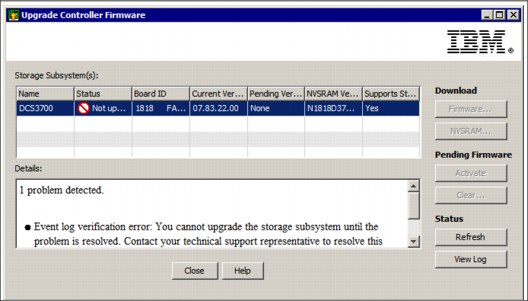
Figure 14-8 Upgrade Controller Firmware window
If the firmware upgrade tool reports a status of non-upgradeable, as shown in Figure 14-8, you can click View Log to review the cause of the non-upgradeable status. Figure 14-9 shows the upgrade log.

Figure 14-9 Viewing the firmware upgrade tool log
In this example, the problem that was preventing a firmware upgrade was fixed by clearing the DCS3700storage subsystem event log. For instructions about how to clear the subsystem event log, see 13.12, “Event Log” on page 410. However, certain types of problems require that you contact your local IBM Customer Support representative.
3. If the firmware upgrade tool does not detect any problems that would prevent the upgrade, the tool reports a status of Upgradeable, as shown in Figure 14-10.

Figure 14-10 Upgrade Controller Firmware

Figure 14-11 Download Firmware window
There are two main sections to this window:
– Current versions: This section reports the versions of controller firmware and NVSRAM that are installed.
– Select files: This section is where you select the firmware and NVSRAM files that you want to transfer to the DCS3700storage subsystem. Information about the firmware and NVSRAM file packages that you select is also displayed in this section.
|
Note: The Download NVSRAM file with firmware check box is enabled by default. Always transfer the firmware and NVSRAM at the same time.
|
a. In the Selected firmware file pane, click Browse and select the firmware upgrade file, as shown in Figure 14-12.

Figure 14-12 Select firmware file
b. In the Selected NVSRAM file pane, click Browse and select the NVSRAM file that you want to transfer (Figure 14-13).
|
Attention: Ensure that you choose the version of the NVSRAM file that is appropriate for your DCS3700storage subsystem. For example, if your DCS3700storage subsystem has two controllers, you must select the dual controller NVSRAM file. If your DCS3700storage subsystem has one controller, you must select the single controller NVSRAM file.
|

Figure 14-13 Select the NVSRAM file
5. If you want to transfer the firmware and NVSRAM and activate them immediately, then click OK. You are prompted to confirm that you want to transfer and activate the firmware and NVSRAM immediately (see Figure 14-14).
|
Note: The process to transfer the firmware and NVSRAM images to the DCS3700 storage subsystem, but activate them later, is described in step 6 on page 439.
|

Figure 14-14 Transfer and activation confirmation window
Click Yes to start the transfer and activation. The firmware upgrade tool begins transferring the firmware images to the controllers. The status can be monitored in the tool (Figure 14-15).

Figure 14-15 Firmware upgrade in progress
Figure 14-16 shows the status after the firmware is transferred and activated.

Figure 14-16 Successful firmware transfer and activation
6. The default procedure is to transfer the firmware and NVSRAM and activate the new versions immediately. However, you can decide to transfer only the firmware and NVSRAM now, and then activate the firmware and NVSRAM later by completing the following steps:
a. To transfer the firmware and NVSRAM, select the Transfer files but don’t activate them (activate later) check box at the bottom of the Download Firmware window (see Figure 14-17).

Figure 14-17 Transfer firmware and NVSRAM only (activate later)
b. Click OK. You are prompted to confirm that you want to transfer the firmware and NVSRAM now but activate the new versions later (Figure 14-18).

Figure 14-18 Confirm Download
c. The status of the transfer of the firmware and NVSRAM can be monitored in the tool, as shown in Figure 14-19.

Figure 14-19 Transferring the firmware and NVSRAM
d. Figure 14-20 shows the status after the firmware and NVSRAM are transferred. The status is reported as Firmware pending and the Activate button is now functional.

Figure 14-20 Firmware activation pending
|
Note: A pending firmware upgrade can also be activated in the DS Storage Manager (Subsystem Management) window by clicking Upgrade → Controller Firmware → Activate....
|

Figure 14-21 Confirm activation
f. Enter yes in to the box to confirm that you want to activate the pending firmware and click OK.
The activation process can take some time to complete, but the status of the process can be monitored in the tool. Figure 14-22 shows the status after the firmware is successfully activated.

Figure 14-22 Firmware activated successfully
7. It is also possible to clear a pending firmware and NVSRAM upgrade image that has been transferred to the DCS3700 storage subsystem but not yet activated.
|
Note: You can also clear a pending firmware upgrade in the DS Storage Manager (Subsystem Management) window by clicking Upgrade → Controller Firmware → Clear....
Note: This step was taken for information purposes only; it is not a necessary step in the upgrade procedure.
|
|
Note: You must click Refresh for the Clear button become enabled.
|

Figure 14-23 Pending firmware upgrade
b. You are prompted to confirm that you want to clear the pending firmware upgrade, as shown in Figure 14-24.
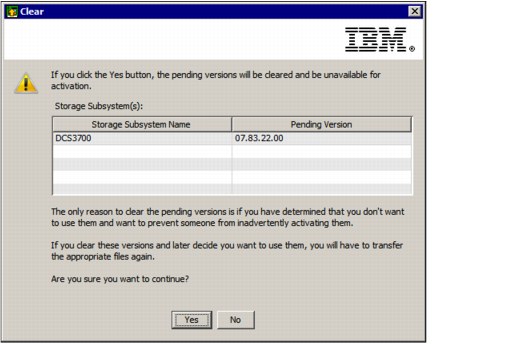
Figure 14-24 Clear pending firmware upgrade
c. Click Yes to clear the pending firmware upgrade and the Clear Pending Firmware Progress window that is shown in Figure 14-25 opens.

Figure 14-25 Clear Pending Firmware Progress
d. The Upgrade Controller Firmware window reports the status that is shown in Figure 14-26 after the firmware is cleared.

Figure 14-26 Status after the pending firmware is cleared
8. You can also use the upgrade tool to install only an updated NVSRAM file:

Figure 14-27 Download NVSRAM
b. Click Browse to select the appropriate NVSRAM file (either single controller or dual controller NVSRAM) for your DCS3700 storage subsystem (Figure 14-28).

Figure 14-28 Download NVSRAM with the NVSRAM file selected

Figure 14-29 Confirm Download
d. You can monitor the status of the NVSRAM upgrade in the Upgrade Controller Firmware window. Figure 14-30 shows the status after the NVSRAM is transferred and activated successfully.
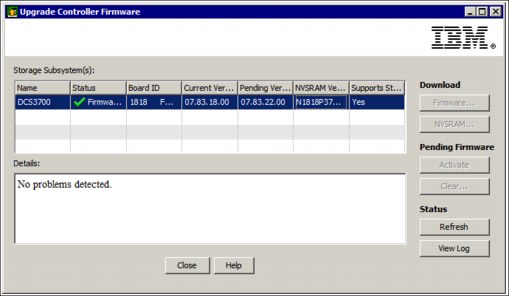
Figure 14-30 NVSRAM upgrade successful
14.3.5 Using the DCS3700 Storage Manager (Subsystem Management)
This section describes the upgrade procedure for the DCS3700firmware and NVSRAM by using the DS Storage Manager (Subsystem Management) application.
Updating the storage subsystem
After you have updated your hosts (as described in 14.2.3, “Updating the host” on page 427), you can update the code of your storage subsystem. To do this, click Upgrade → Controller Firmware → Upgrade..., as shown in Figure 14-31.
|
Tip: The current DCS3700firmware levels are listed in the storage subsystem profile. Clicking Upgrade... also displays the current firmware levels of the
respective components. |

Figure 14-31 Upgrade menu
|
Note: The term “Download” in these links means to update the actual firmware on the hardware. Before starting any of these operations, you must have already obtained or downloaded the appropriate microcode from the IBM Support website.
|
Download Controller Firmware
To install the DCS3700 storage subsystem firmware, complete the following steps.
|
Attention: Each firmware file has a version number. The version number indicates whether the firmware is a major version or a minor version. The procedure that is described in this section describes how to download and activate only the minor firmware versions. However, you can use the Enterprise Management window to download and activate both major and minor firmware versions. The procedure that uses the Enterprise Management window to download and activate the controller firmware is described in 14.3.4, “Using the Enterprise Management upgrade tool” on page 430.
|
1. To update the controller firmware by using the DS Storage Manager, click Upgrade..., as shown in Figure 14-31.
2. Every time that you click Upgrade, a warning message displays for an automatic pre-upgrade check, as shown in Figure 14-32.

Figure 14-32 Pre-upgrade check warning message
3. Sometimes after you click OK, a warning window might open because the DCS3700 storage subsystem has logged too many critical events.
You must view the DCS3700event log and resolve the errors (as described in 13.12, “Event Log” on page 410). In our testing lab environment, clearing the DCS3700storage subsystem event log fixed the condition that was causing the verification error. If you are unable to fix the condition that prevents the firmware upgrade, contact your local IBM Customer Support representative.
4. If there are no event log verification errors, then the Download Controller Firmware window opens, as shown in Figure 14-33.

Figure 14-33 Download Controller Firmware
The Download Controller Firmware window has two sections. The first section, Controller Firmware, is where you select and specify the controller firmware file to be transferred. In the second section, NVSRAM, you select and specify the NVSRAM firmware file to transfer together with the controller firmware upgrade. When you select this option, both the controller firmware and controller NVSRAM upgrades are done in one step.
|
Note: Install the controller firmware and controller NVSRAM updates in one step.
|
5. Click Select File in the Controller Firmware section and enter or browse to the file name.
6. To update the NVSRAM in the same step, select the Transfer NVSRAM file with controller firmware check box and browse to the NVSRAM file (Figure 14-34).

Figure 14-34 Download Controller Firmware with NVSRAM firmware
|
Note: It is a preferred practice to transfer files but not activate them in one step, as shown in Figure 14-34.
|
7. Click Transfer to submit the new microcode to the storage subsystem. The Confirm Download window opens (Figure 14-35). Read it and click Yes to continue.
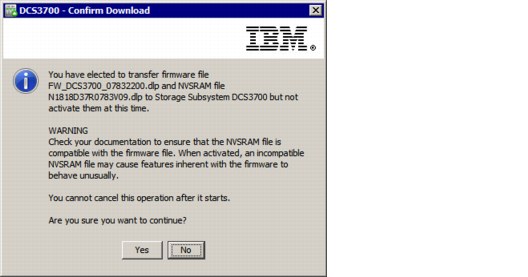
Figure 14-35 Confirm Download
8. The microcode is transferred to the storage subsystem and applied to both installed controllers. This procedure can take some time. You can monitor the status in the Downloading window that opens (Figure 14-36).

Figure 14-36 Downloading the firmware with activation postponed
After the controller firmware is transferred, it is necessary to activate both controllers. This step can also take some time.
To start the activation process, click Upgrade → Controller Firmware → Activate.... A warning window opens, as shown in Figure 14-37.

Figure 14-37 Activate Firmware warning window
Click Yes to proceed with the activation. The status is reported, as shown in Figure 14-38.

Figure 14-38 Activating the firmware

Figure 14-39 Download successful
|
Note: If the firmware version is going from Version 07.77.20.00 to 07.83.22.00, as it is in this example, you might see the warning show in Figure 14-39 prompting you to close and reopen Storage Manager, even if you are running the latest version. This step is needed to reload all the new features that are described in this book.
|
14.4 Controller NVSRAM
To install the controller NVSRAM, complete the following steps.
|
Note: To access the Download Controller NVSRAM function, click Upgrade → Controller NVSRAM.
|
1. To download a new NVSRAM file to your storage subsystem, open the associated window (Figure 14-40). Click Select File to select the NVSRAM file.

Figure 14-40 Download Controller NVSRAM
3. After you select the NVSRAM file that you want to install, click Transfer... to begin installing the new NVSRAM file on the storage subsystem. The Confirm Download window opens (Figure 14-41). Read the information and click Yes to start the NVSRAM download.

Figure 14-41 Confirm NVSRAM download
4. The Downloading window opens and shows you the status of the transfer and the activation on the controllers, as shown in Figure 14-42.
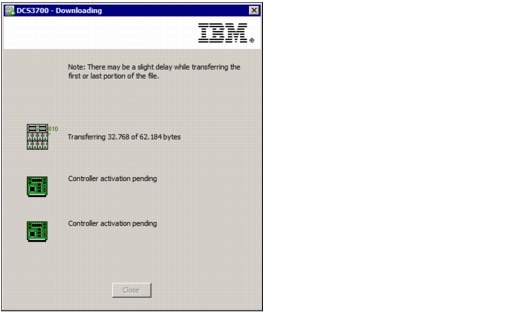
Figure 14-42 Download progress of NVSRAM
5. After the NVSRAM file is transferred and activated successfully, click Close.
14.5 Drive firmware
The hard disk drive firmware upgrade process is disruptive and requires that all host I/Os be suspended during the update. Plan a production outage in advance and complete the following steps (when I/O operations are suspended) to perform the drive firmware upgrade.
|
Note: You can access the Download Drive Firmware function by clicking Upgrade →
Drive Firmware. |
1. With the Download Drive Firmware wizard open, read the information that is displayed on the introduction window (Figure 14-43) and then click Next.

Figure 14-43 Download Drive Firmware - Introduction window
2. The Download Drive Firmware - Add Packages window opens (Figure 14-44). This window has two main sections:
– The Current package section contains a list of all the drive models and the firmware levels that are installed on each of these drive models.
– The Selected packages section contains the list of firmware package files to be transferred after you have added them.
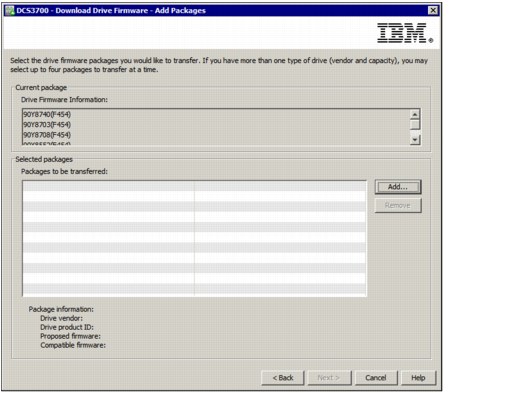
Figure 14-44 Select drive firmware package
3. Click Add to open the Select A Package window and browse to the folder that contains the drive package files.
As you highlight each package that is listed, the File Information section reports if the selected drive firmware package is Compatible (Figure 14-45) or Not Compatible (Figure 14-46) with the types of drives that are installed in your system.

Figure 14-45 Drive firmware is compatible

Figure 14-46 Drive firmware is not compatible
4. Repeat these steps for every drive type that you want to update. You can update up to four drive types at a time. After you have selected the compatible drive firmware packages, click Next in the Download Firmware window to continue.
5. Now you must select the drives in the subsystem you want to update. You see only the compatible drives in this window. Check Select all to update all compatible drives.
6. The drives that are not compatible with the selected updates are shown in the Incompatible Drives tab (Figure 14-47). These are other drive types, and you will have to use other firmware packages.
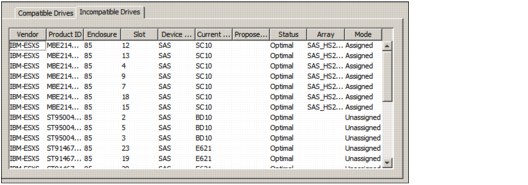
Figure 14-47 Incompatible drives tab
7. Click Finish to update the drive firmware. A confirmation window opens. Enter yes and click OK to start the update.
8. After the update completes, a summary window opens (Figure 14-48). If you want to update more drives, click Transfer More to select the compatible packages. Otherwise, click Close to exit the drive update window.

Figure 14-48 Drive update complete
14.6 ESM firmware
To install the ESM firmware for the EXP3500 enclosures, complete the following steps:
1. To update the ESM code, open the Download Environmental (ESM) Card Firmware window by clicking Upgrade → ESM Firmware. Figure 14-49 shows the window.

Figure 14-49 Download Environmental (ESM) Card Firmware
2. There are two sections in this view. The top section, Drive enclosures, lists all the installed enclosures. You can either select which enclosures to update or select the Select All check box to update all the connected enclosures.
In the second section, ESM firmware, select the ESM firmware file that you downloaded previously from the IBM Support website. Click Select File and select the firmware file.
Click Start to update the ESM firmware.
3. The Confirm Download window opens. Read the information, confirm it by entering yes, and click OK to start the update (Figure 14-50).

Figure 14-50 Confirm Download
4. The status field in the row of selected enclosures changes from Pending to Transferring while the ESM card firmware upgrade progresses. Monitor the progress and completion status of the download, as shown in Figure 14-51.

Figure 14-51 Transferring the ESM firmware
5. The status changes to Completed when the ESM firmware is downloaded, as shown in Figure 14-52.

Figure 14-52 ESM firmware transfer completed
14.7 Enclosure configuration settings
To install new ESM configuration settings from a file, complete the following steps.
.
|
Note: You can access the Download ESM configuration settings function by clicking Upgrade → Enclosure Configuration Settings.
|
1. To download ESM configuration settings, select the Enclosure Configuration Settings option, as shown in Figure 14-31 on page 448. The window that is shown in
Figure 14-53 opens.
Figure 14-53 opens.

Figure 14-53 Download ESM card configuration
2. If there is more than one drive enclosure that is connected to the DCS3700 storage subsystem, select the Select All check box to install the ESM configuration file to all of the enclosures. Alternatively, if you want to install the ESM configuration file to just one enclosure, select only that enclosure in the list of enclosures.
3. Click Select File and specify the ESM configuration file that you want to transfer.
4. Click Start. You are prompted to confirm that you want to proceed. Enter yes in the text box and click OK to continue.
..................Content has been hidden....................
You can't read the all page of ebook, please click here login for view all page.
